Lady era
Lady era dosages: 100 mg
Lady era packs: 30 pills, 60 pills, 90 pills, 120 pills, 180 pills, 270 pills, 360 pills
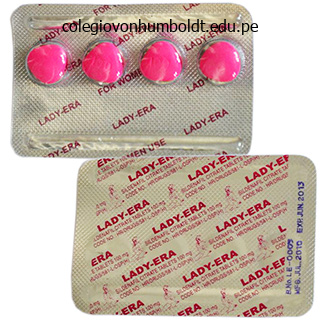
Purchase lady era 100mg amex
Osteopontin, a key part of the hematopoietic stem cell niche and regulator of primitive hematopoietic progenitor cells. Osteopontin is a hematopoietic stem cell area of interest element that negatively regulates stem cell pool measurement. Stem cell engraftment at the endosteal area of interest is specified by the calcium-sensing receptor. Proceedings of the National Academy of Sciences of the United States of America 1995;92(15):7075�9. The transcription factors Scl and Lmo2 act collectively throughout growth of the hemangioblast in zebrafish. Lmo2 and Scl/Tal1 convert non-axial mesoderm into haemangioblasts which differentiate into endothelial cells in the absence of Gata1. The Hox cofactor and proto-oncogene Pbx1 is required for maintenance of definitive hematopoiesis in the fetal liver. Differential expression of Hox, Meis1, and Pbx1 genes in primitive cells all through murine hematopoietic ontogeny. HoxB4 confers definitive lymphoidmyeloid engraftment potential on embryonic stem cell and yolk sac hematopoietic progenitors. Mel-18, a polycomb group protein, regulates cell proliferation and senescence by way of transcriptional repression of Bmi-1 and c-Myc oncoproteins. A gene expression profile of embryonic stem cells and embryonic stem cellderived neurons. The Drosophila polycomb protein interacts with nucleosomal core particles in vitro via its repression domain. A advanced with chromatin modifiers that occupies E2F- and Myc-responsive genes in G0 cells. Polycomb group gene rae28 is required for sustaining exercise of hematopoietic stem cells. Bmi-1 dependence distinguishes neural stem cell self-renewal from progenitor proliferation. Bmi-1 promotes neural stem cell self-renewal and neural development however not mouse development and survival by repressing the p16Ink4a and p19Arf senescence pathways. Defects in mesenchymal stem cell self-renewal and cell destiny dedication result in an osteopenic phenotype in Bmi-1 null mice. Bmi-1 is required for maintenance of grownup self-renewing haematopoietic stem cells. Enhanced self-renewal of hematopoietic stem cells mediated by the polycomb gene product Bmi-1. Polycomb group gene mel-18 modulates the self-renewal exercise and cell cycle status of hematopoietic stem cells. Reciprocal expression of Bmi1 and Mel-18 is associated with functioning of primitive hematopoietic cells. Functional antagonism of the Polycomb-Group genes eed and Bmi1 in hemopoietic cell proliferation. Ex vivo targeting of p21Cip1/Waf1 permits relative enlargement of human hematopoietic stem cells. Differential impression of Ink4a and Arf on hematopoietic stem cells and their bone marrow microenvironment in Bmi1deficient mice. Rb is dispensable for self-renewal and multilineage differentiation of grownup hematopoietic stem cells. Proceedings of the National Academy of Sciences of the United States of America 2006;103(24): 9057�62. The cellular basis of the genetically decided hemopoietic defect in anemic mice of genotype Sl-Sld. Proceedings of the National Academy of Sciences of the United States of America 1997;94(9):4698�703. Common and distinct options of cytokine results on hematopoietic stem and progenitor cells revealed by dose-response floor evaluation. Targeted disruption of the flk2/ flt3 gene leads to deficiencies in primitive hematopoietic progenitors. Mice missing flt3 ligand have deficient hematopoiesis affecting hematopoietic progenitor cells, dendritic cells, and natural killer cells. Expansion in vitro of grownup murine hematopoietic stem cells with transplantable lympho-myeloid reconstituting capacity.
Syndromes
- Having sex at an early age
- Benign juvenile lordosis (not medically significant)
- Returns after the nitroglycerin helped at first
- Irregular pulse
- Infection (a slight risk any time the skin is broken)
- Croutons
- Urine stream starts and stops (urinary intermittency)
- Use safe sex practices to prevent HIV and STDs.
- Phenytoin
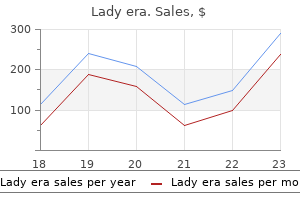
Cheap 100 mg lady era visa
Individually coloured peaks (series of vertical bars) characterize multiple cost states of a single amplicon (allele). Actual base compositions could differ by up to one base from precise base compositions beneath some circumstances (specifically, when pairs of substitutions end in single Dalton variations in mass). This ambiguity is accommodated by the software used to match base compositions with signatures in the associated database. Primary and secondary check with the relative apparent titer of multiple detections from the same primer pair c Base rely proximities represent the variations in base composition relative to the closest match within the database of known strains for each of the four nucleotides. The H1N1pdm viruses have been additionally distinguishable from the triple reassortant swine H1N1 in any respect six targets (compare yellow and purple signature). Differences in colour patterns throughout the identical subtype either displays completely different genetic teams (H3N2 and H1N1), or a single nucleotide polymorphism (2009 H1N1 pdm). The numbers preceded by letters in every box correspond to the bottom counts (number A, G, C, and T) determined from the amplicons of the respective target genes. Two clade-specific primer pairs are also included to verify identification of important infectious organisms including Staphylococcus aureus. Discussion here is proscribed to the broad-spectrum bacterial identification capabilities of the assay. These primers were chosen to insure priming of a number of loci in every phylogenetic clade of bacteria. Automated results reporting for the broad bacterial assay is limited to those bacterial species for which direct demonstrations of sensitivity and accuracy of detection might be made. The broad bacterial assay has been validated experimentally with over one hundred species of bacteria and is theoretically capable of identifying over 500. It also can detect and identify generally rare and surprising agents capable of causing epidemics or locally excessive charges of endemic disease in specific areas, together with Yersinia pestis (the agent of the plague) and Bacillus anthracis (anthrax-both an occasional environmental health hazard and a potential biowarfare agent), as demonstrated utilizing a earlier prototypical version of the assay [11]. High-Resolution Strain Analysis for Epidemiological Tracking Bacteria usually evolve slowly, and really threatening bacterial epidemics or outbreaks are likely to outcome from either gene transfer (resulting within the acquisition by one strain of new virulence components or antibiotic resistance factors) or deliberate release of bacteria in biowarfare assaults. In such circumstances, the initial want is to determine the species causing sickness, and the secondary need is to develop and deploy strain-specific markers to observe emergent strains and define the sources and the epidemiology of outbreak. Colored cells represent individual base-composition signatures found for the 332 organisms tested (rows) in the 9 loci (columns) that have been used for broad bacterial identification. Row height often varies as two or three distinct base counts could additionally be discovered throughout the same locus for some organisms. Cells are left clean when no signature was found for the corresponding organism and locus. The majority of isolates had been members of wellrecognized European clades associated with hospital transmission, suggesting that the hospitals at which the patients had been initially handled in Europe have been the proximal supply of infection. Analysis of 415 further samples allowed the development of a very informative epidemiological comparison between a number of army sites and indicated that pressure turnovers result from geographically widespread adjustments in strain dominance. Each column corresponds to a single isolate, and cells are coloured in darkish grey (resistant), medium gray (intermediately resistant), or gentle gray (susceptible), in accordance with the level of resistance. All identities are proven as "id (number identified)" for that particular associative class 458 Table 25. Positives either carry a specific spe gene or present resistance to a specific antibiotic (inclusive of both intermediate and full resistance). Temporally aligned emm sort distributions for 2 websites that constantly contributed samples. As with sequence comparison methodologies, the extra narrowly focused the assay, the larger the phylogenetic resolution of the ensuing knowledge. However, if associated organisms targeted by the same primer pairs are present in very different concentrations, competitors will likely obviate detection of the much less concentrated part. Furthermore, if many associated organisms are current collectively in the same pattern then the ensuing collections of a quantity of mass identities for every amplified locus, combined with signature overlaps between components, might exceed the computational capability of the analysis platform to properly deconvolute the information into particular person units of signatures matched to particular targets. Throat swabs, nasal swabs, and different nonsterile samples are much less prone to afford clear, unambiguous detections of pathogens due to the presence of high titers of a number of carrier-state micro organism.
Buy lady era on line amex
Recognition of this pathway is essential as a end result of it appears to resolve a long-standing argument regarding the origin of platelet fibrinogen. Defibrination of animal models, adopted by histochemical and cytochemical research of bone marrow and platelets, has shown that platelet fibrinogen originates from blood. The strategy of secretion has been characterized as a switch of chemical substances confined in storage organelles of resting platelets to the exterior plasma with out simultaneous lack of cytoplasmic constituents. One theory means that organelles transfer to the periphery of activated platelets, fuse with the cell membrane at any point, and extrude their contents to the surface. A related sequence of occasions has been observed in the course of the means of secretion in lots of endocrine systems. Their evidence indicated that the sealed vacuole shaped by granule fusion strikes to the periphery of activated cells and fuses with the plasma membrane, resulting in launch. Alpha-granule fusion ensuing in the formation of giant organelles is frequent in sufferers with myeloproliferative syndromes or myelomonocytic leukemia. Shape change and pseudopod formation following exposure to agonists are accompanied by internal modifications. Fusion of alpha granules to kind big organelles is common during long-term storage. The chemical dye was present in a preliminary investigation to precipitate fibrinogen and selectively deposit osmic acid on fibrinogen and fibrin. The cells lose their lentiform appearance, turn into irregular in form, and lengthen numerous pseudopods. Platelet organelles turn out to be concentrated in cell facilities and enclosed within rings of constricted microtubules. Higher concentrations of thrombin trigger fast discharge of granule contents and reduction in their quantity. As a end result, dense spots of actomyosin, during which centrally concentrated organelles are enclosed in much less activated platelets, appear more distinguished in strongly stimulated cells. Amorphous black material surrounded the aggregates and was deposited between the cells. Electron-dense material was also current in normal-sized and swollen granules in many platelets. Connections between channels and granules and direct communication between canaliculi and the encircling plasma had been evident. Other granules had been swollen and their content of amorphous stained materials appeared diluted. The connection appeared to foster swelling of the granules and dilation of the channels, so that recognition of the location of fusion was typically obscured. More than one granule was frequently in communication 499 32 Blood and bone marrow pathology. The pattern was mounted in glutaraldehyde containing tannic acid 3 min after exposure to the agonist without stirring. Tannic acid acts as a selective mordant, binding osmic acid to fibrin and fibrinogen beneath these conditions, allowing ultrastructural identification of the secretory process. Occasionally, channel openings on to the surface were dilated, however often remained constricted as in resting platelets. In some examples a single channel opened in a couple of place on to the surface membrane of an activated platelet. The electron-dense materials present in channels regularly appeared within the process of extrusion into the surrounding medium. The difference within the mechanism of secretion in bovine in comparison with human cells could appear complicated. As a outcome, they use the floor membrane as the primary route for discharge of products from secretory granules. Bovine platelets can develop primitive canaliculi following activation and granule merchandise can go away the cell by way of these conduits. The foundation for the species variations in platelet structure leading to different most well-liked routes for secretion of granule products remains unknown. The unique patient75 was evaluated for thrombocytopenia as a child and located to have massive, nearly agranular platelets which appeared gray or blue�gray on Wright-stained blood smears. Most of his platelets retained the big agranular look famous earlier than splenectomy, but a small percentage have been of normal size and contained some granules. However, the reaction of gray platelets to collagen and thrombin was lower than regular.

Discount 100mg lady era with amex
Electrophoresis 20:1280�1300 Chapter 23 Microarray-Based Amplification Product Detection and Identification Joy D. Gentry, and Jizhong Zhou Introduction Microorganisms play essential roles in ecosystem functioning in each the setting and within host organisms. However, the range of microbial communities (an estimated 2,000�50,000 microbial species per gram of soil [1�4] and the human gut is estimated to comprise a minimum of 500 phylotypes [5]) and their largely unculturable standing (>99 % [6�8]) make them tough to examine. As such, culture-independent approaches are important to study even a fraction of microorganisms in the surroundings. Due to the big quantity of knowledge generated from each array, array-based analyses can be extra costeffective than different molecular strategies. In addition, arrays are an ideal tool for comparing microbial communities from totally different websites, circumstances, or instances since samples are interrogated towards an outlined set of genes or microorganisms contained on the array. These options make microarrays excellent instruments for assessing microbial neighborhood structure, functions, actions, and dynamics in natural settings. This chapter discusses numerous forms of arrays and their applications to issues of clinical curiosity. Zhou (*) Institute for Environmental Genomics and Department of Microbiology and Plant Biology, University of Oklahoma, one hundred and one David L Boren Blvd. Principles and Types of Microarrays Microarrays are comprised of probes for particular genes, sequences, or genomes on a strong floor. This is conceptually similar to conventional membrane-based Northern and Southern blots the place a labeled probe molecule is hybridized to goal nucleic acid attached to a membrane, solely reversed. Microarrays can be manufactured on glass slides [9�11] or nylon membranes [12]; though, sometimes, glass slides are used since they produce less background fluorescence [13, 14] and permit greater probe density [15]. Variations in spot dimension are accomplished by adjusting the laser energy with spots as small as 40 mm. Roche NimbleGen makes use of Maskless Array Synthesizer expertise to synthesize probes directly onto the glass array surface. Additionally, contact printing using printing pins is regularly used for in-house laboratory array printing. Several kinds of arrays could be utilized in medical and diagnostic applications or research. In basic, a shorter probe size (~20mers) is critical to present the needed degree of specificity. However, using this kind of probe significantly limits the quantity and type of genes that could possibly be included on the array because of limits in primer availability and issue in obtaining giant numbers of pure culture isolates. These arrays have been developed to provide a really complete probe set masking many useful gene teams while offering the specificity essential to distinguish almost homologous sequences [29]. Selected genes ought to encode a protein important to the process of interest, be pretty conserved however have sufficient sequence divergence to permit design of particular probes, and have a relatively massive sequence set available in public databases [27]. Unhybridized probes had been assumed to be from uncultured strains and have been subsequently sequenced. Several different studies have used this similar approach to examine relatedness together with Klebsiella pneumoniae an E. Other Arrays Other novel arrays have been developed and will have application in clinical analysis and analysis. This methodology demonstrated the next resolution than different strategies similar to gel electrophoresis and could even differentiate comparable strains of microorganisms. A comparatively new sort of microarray is the sequence seize array, which was designed to selectively enrich human nucleic acid samples for exons [55, 56]. These arrays cover a complete gene loci utilizing oligonucleotide probes (>60mer) spaced approximately 1�10 bases aside throughout the complete sequence [55]. Another array, the Symbiosis Chip, contains probes for each Sinhorhizobium meliloti, a symbiotic a-Proteobacterium, and the host plant, Medicago truncatula, allowing examination of concurrent gene expression within the symbiont and the host underneath the very same hybridization conditions [58]. Pathogen Detection, Virulence Markers, Antibiotic Resistance, and Diagnostics Microarray expertise could be applied to field of pathogen detection either in medical settings as a diagnostic tool or in meals and water security testing and studies have shown this to be a promising expertise in these fields (Table 23. In addition, advances in hybridization know-how will make microarray use more practical in clinical settings for high-speed, high-throughput diagnosis and testing.
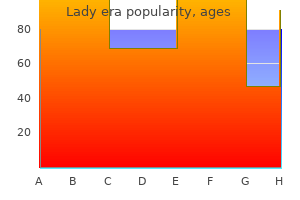
Order lady era mastercard
If the single- or multidrug therapy is used episodically, resistant tubercle bacilli multiply underneath selective strain and emerge quickly [7, 20]. Unfortunately, second-line medicine have inherently identified extra poisonous and fewer effective than first-line medicine [25]. Collection of fine high quality specimens containing the best number of mycobacteria is important for diagnosis. Specimen should be despatched to the laboratory inside 30 min or at most within 24 h after assortment [28]. Expectorated sputum specimen ought to be collected early within the morning on three occasions and sent to laboratory in a wide-mouthed, sterile, plastic container (wax free) with a tight fitting cap at 0�4 �C. Gastric lavage specimen ought to be collected earlier than breakfast on three separate occasions [6]. Midstream urine specimens ought to be collected in a sterile plastic container (wax free) with a leak-proof cap at three early mornings. Fluids ought to be processed promptly and inoculated right into a liquid progress medium as well as a strong media. It can be expected that specimens collected from nonsterile websites be contaminated by regular microflora. Therefore, in order to cut back contamination by regular flora, decontamination processes are essential. Following decontamination, specimens are neutralized with buffer and concentrated by centrifugation. It is important that reference laboratory report outcomes of acid-fast stain within 24 h of receiving the specimens. In this technique, as a result of mycolic acid-rich cell wall, carbol fuchsin dye is retained after washing with acid alcohol. It has proven that this system increases the sensitivity of sputum smears by almost 10% over standard staining [30]. Traditional Culture Techniques Mycobacterial tradition remains the gold standard for detection and drug susceptibility testing. In order to culture mycobacteria from scientific specimens, there are numerous kinds of solid and liquid media corresponding to Lowenstein-Jensen, Kirchner, and the varied Middlebrook formulations (7H9, 7H10, and 7H11) [32]. Specimens contaminated with normal bacterial flora such as sputum are inoculated in a selective medium containing antimicrobial brokers; sterile body fluids are inoculated with stable and a broth media [9]. The progress of solid tradition media is 6 weeks or longer whereas that of liquid tradition media is often 7�21 days. The major advantages of strong cultures are that they make it possible to look at the morphology of colonies and visualize the pigmentation. Kilic Biochemical Tests and Morphological Features There are numerous sorts of biochemical checks and morphological features for identification of mycobacteria. Based on pigment manufacturing, mycobacteria are classified into three teams: photochoromogens, scotochromogens, and nonchromogens. Nonchromogens are nonpigmented in each mild and dark, but solely have gentle tan or buff-colored colonies [7, 33]. Growth fee, colony morphology, and biochemical exams are different necessary differentiating factors among mycobacteria. Mycobacteria that grow less than 14 days are called speedy growers, and those who grow after 14 days are referred to as slow growers. Examination of the morphology of colonies is necessary particularly in combined cultures. There are additionally different checks such as manufacturing of catalase or urease, arylsulfatase take a look at, iron uptake, tween hydrolysis, tellurite reduction, and constructive niacin check, which help within the prognosis of tuberculosis [33]. This technique relies on radiometric evaluation of liquid progress medium containing palmitic acid, labeled with radioactive carbon (14C-palmitic acid) as the substrate [28]. The benefit of this methodology is lowered detection time of each smear-positive and smear-negative samples by practically 50%; additionally the bacterial growth could be detected in 5�10 days [35, 36]. This fluorescence-based system uses an oxygen particular sensor to detect the mycobacterial development [38, 39]. The decrease threat of cross contamination and data administration has tremendously facilitated its use [41]. It makes use of a gas-permeable sensor embedded in a colorimetric indicator at the backside of culture vials. Every incubating drawer in instrument is monitored by reflometric detection unit [48].
Myo-Inositol (Inositol). Lady era.
- Problems metabolizing fat, high cholesterol, inability to sleep, attention deficit-hyperactivity disorder (ADHD), cancer, hair growth, and other conditions.
- Panic disorder.
- Dosing considerations for Inositol.
- Autism.
- Are there safety concerns?
- What other names is Inositol known by?
- Obsessive-compulsive disorder (OCD).
- How does Inositol work?
- Depression.
- An ovary disorder known as "polycystic ovary syndrome."
Source: http://www.rxlist.com/script/main/art.asp?articlekey=96321
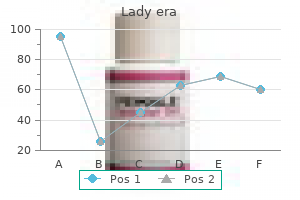
Discount 100 mg lady era amex
Dunbar has elevated dramatically for Flu-A/H3N2 and Flu-A/H1N1, and increasing oseltamivir resistance for seasonal Flu-A/H1N1 has been reported worldwide since 2007 [49�51]. Currently, resistance testing is completed by sequencing or phenotypic assays which could be costly and time consuming; nevertheless, a multiplexed bead-based array might be applied for this purpose in combination with or in addition to a complete respiratory viral panel. Of the 17 seasonal Flu-A/H1N1 isolates, H275Y was identified in 15, and of the 24 pandemic 2009 Flu-A/H1N1 isolates, 12 were H275 (sensitive), 3 have been H275Y (resistant), and 9 revealed a mixture of each alleles. An operational workflow analysis utilizing lean methodology principles was employed in another examine to evaluate potential advantages of a multiplexed bead-based array for laboratory workflow and related cost [54]. Workflow was evaluated by means of whole hands-on time and variety of operator steps, and all hospital and laboratory costs related to testing had been calculated for every check for both constructive and adverse end result eventualities. The additional time and costs related forty two Bead-Based Suspension Arrays for the Detection and Identification. Thus, the bead-based array assays not only provide elevated diagnostic functionality for respiratory viral infections but can even maximize efficiency and scale back the prices associated with analysis. Conclusions Recent advances in molecular diagnostics have offered the clinical laboratory with new strategies that enable rapid diagnosis and treatment of infectious diseases. Among these, multiplexed bead-based suspension arrays have emerged as a rapid, high-throughput, and cost-effective means to present physicians with dependable and actionable results for timely and improved affected person care. In explicit, bead-based suspension array assays have been demonstrated as a way of selection for the comprehensive detection and identification of respiratory viruses and have improved analysis, allowed identification of coinfections, provided useful epidemiological knowledge, and aided within the response to outbreaks of respiratory infections. It can be anticipated that as new assays are developed and current assays are frequently enhanced and improved with less complicated protocols, streamlined workflows, and automation, these assays will proceed to prove useful for analysis of respiratory viruses and different infectious ailments. Recommendations for scaling up or cutting down oligonucleotide coupling reactions. Armstrong B, Stewart M, Mazumder A (2000) Suspension arrays for top throughput, multiplexed single nucleotide polymorphism genotyping. J Clin Microbiol 45(7):2105�2109 42 Bead-Based Suspension Arrays for the Detection and Identification. Meijer A, Lackenby A, Hungnes O et al (2009) Oseltamivir-resistant influenza virus A [H1N1], Europe, 2007�08 season. J Mol Diagn 13(2):175�179 Chapter 43 Molecular Diagnosis and Monitoring of Human Papillomavirus Infections Bruce K. More lately, new- or second-generation cervical most cancers diagnostics concentrating on completely different aspects of the mechanism of cervical most cancers pathogenesis have been brought into scientific use and added much wanted specificity to the cervical cancer screening algorithm [7]. In particular, dialogue focuses on the relationship between the diagnostic goal and the pathogenesis of cervical most cancers as the sphere makes an attempt to direct diagnostics towards detection of lesions requiring treatment and decrease the number of girls despatched to pointless, invasive procedures. Liquid cytology preservatives are usually alcohol based (ethanol or methanol) and, normally, include compounds that dissolve mucus and disaggregate cells. All applied sciences create a slide that incorporates a monolayer of consultant cells from the ecto- and endocervix stained by the strategy of Pap. Isolation of epithelial cells is completed by eradicating interfering particles and inflammatory cells by centrifugation through a density gradient. After centrifugation, the tubes including cell pellets are placed on the PrepStain System for staining using the Pap stains. To provide additional savings, no special coated slides are required; so any lab slide can be utilized. As is discussed in subsequent sections, liquid-based cervical cytology has significantly aided the usage of automated screening gadgets and the automation of superior molecular and proteomic assays. This determine illustrates the detection of various stages of illness and where in the disease process various diagnostic checks detect adjustments 838 B. A summary of the efficiency of commercially available checks follows and the attributes of each test are summarized in Table 43. All of these tests will report at least 15 high-risk varieties (16, 18, 31, 33, 35, 35, 39, 45, 51, fifty two, fifty six, 58, 59, 66, 68). The Aptima test detects genotypes 16, 18, 31, 33, 35, 39, 45, 51, fifty two, fifty six, 58, fifty nine, sixty six, and sixty eight and the other two tests detect sixteen, 18, 31, 33, and forty five. Because p16 staining is a slide-based take a look at, the authors concluded that subjectivity affected reproducibility [39].
Purchase lady era 100 mg visa
Immunodeficient sufferers could fail to generate granulomas in response to organisms that evoke granuloma formation in immunocompetent topics. In tuberculous granulomas, Langhans-type giant cells are often found, caseation is present in about 50% of patients and acid-fast bacilli are usually absent or, when current, found in small numbers. In disseminated Mycobacterium avium intracellulare infection, granulomas of variable measurement and look are seen in about half the cases. Giant cells and necrosis are unusual and macrophages are packed with organisms and should appear foamy. Large granulomas, usually with Langhans-type large cells and scanty organisms and sometimes with caseation, could occur in sufferers with histoplasmosis and reasonably regular immunity. By distinction, sufferers with immune suppression normally ninety one 5 Blood and bone marrow pathology Box 5. In both kinds of affected person, the yeast form of the organism is found inside macrophages. The yeast forms seem blue in Romanowsky-stained movies and are 2�5 �m in diameter. Granulomas can also be seen within the marrow in disseminated Cryptococcus neoformans infection. The organisms (yeasts) are 5�10 �m in diameter, have a thick capsule that appears as a transparent halo in ninety two sections stained with H&E and so they show unequal budding. Caseation is attribute of tuberculosis however is neither invariably current nor restricted to it. Furthermore, noncaseating granulomas with no detectable acid-fast bacilli could typically be as a outcome of tuberculosis quite than sarcoidosis. The granulomas might coexist with other antagonistic reactions similar to neutropenia, eosinophilia, rash and fever. They could include plasma cells, lymphocytes and eosinophils and incessantly occur close to sinusoids or lymphoid nodules. In systemic mastocytosis the lesions are composed of mast cells, eosinophils, lymphocytes and collagen fibers (see Chapter 26) and in angioimmunoblastic T-cell lymphoma of immunoblasts, plasma cells, lymphocytes, histiocytes, eosinophils, arborizing capillaries and reticulin fibers. Circulating malignant cells may occasionally be seen, particularly in kids with small cell tumors and, more hardly ever, in adults with carcinoma. In this circumstance, detection of metastases is dependent on the trephine biopsy. In adults, the tumors that most commonly metastasize to the marrow are carcinomas of the prostate, breast, gastroinB. Generally, carcinoma cells are markedly pleomorphic and have a reasonable amount of barely or reasonably basophilic cytoplasm, typically with vacuoles. However, in other cases this distinction requires cytochemical, ultrastructural and immunochemical studies. In medulloblastoma, tumor cells might show hemophagocytosis and autophagocytosis. Information on the character of malignant cells could also be obtained by immunocytochemistry and immunohistochemistry. The detection of metastatic prostatic carcinoma cells requires the use of antibodies against each prostate-specific antigen and prostatic acid phosphatase. The improvement of myelofibrosis in patients with myeloproliferative neoplasms may be related to secretion of platelet-derived growth issue, remodeling progress factor and platelet issue four (which inhibits collagenase) by megakaryocytes. Whenever extensive dense fibrosis happens, for example in patients with metastatic carcinoma, the hematological findings could mimic these of main myelofibrosis. In major myelofibrosis, necrotic megakaryocytes have been famous in fibrotic areas. In the congenital defect gray platelet syndrome it has been hypothesized that related myelofibrosis could additionally be consequent on the release of granule contents (which could include plateletderived progress factor) from abnormal megakaryocytes. When myelofibrosis is secondary to a nonhemopoietic disorder, reversal of the fibrosis may happen when the first condition is effectively treated. This is also Lysosomes catabolize lipids, carbohydrates, proteins and nucleotides. In a bunch of inherited diseases, mutations in one of many genes encoding a lysosomal hydrolytic enzyme lead to the intracellular accumulation of abnormal amounts of varied substances and consequent scientific manifestations. Gaucher cells additionally stain positively for nonspecific esterase and tartrate-resistant acid phosphatase. In histologic sections, Gaucher cells are sometimes found in clumps or sheets and their plentiful cytoplasm has a crumpled look.
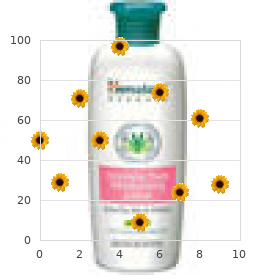
Order lady era 100 mg fast delivery
Kasai H, Ezaki T, Harayama S (2000) Differentiation of phylogenetically associated slowly rising mycobacteria by their gyrB sequences. Adekambi T, Berger P, Raoult D, Drancourt M (2006) rpoB gene sequence-based characterization of emerging non-tuberculous mycobacteria with descriptions of Mycobacterium bolletii sp. J Med Microbiol fifty eight:1030�1036 27 Bacterial Identification Based on Universal Gene Amplification and Sequencing 507 146. Harmsen D, Rothganger J, Singer C, Albert J, Frosch M (1999) Intuitive hypertext-based molecular identification of micro-organisms. Mollet C, Drancourt M, Raoult D (1997) rpoB sequence analysis as a novel basis for bacterial identification. Drancourt M, Raoult D (2002) rpoB gene sequence-based identification of Staphylococcus species. Poyart C, Quesne G, Trieu-Cuot P (2002) Taxonomic dissection of the Streptococcus bovis group by evaluation of manganese-dependent superoxide dismutase gene (sodA) sequences: reclassification of `Streptococcus infantarius subsp. Poyart C, Quesnes G, Trieu-Cuot P (2000) Sequencing the gene encoding manganese-dependent superoxide dismutase for fast species identification of enterococci. Poyart C, Quesne G, Coulon S, Berche P, Trieu-Cuot P (1998) Identification of streptococci to species degree by sequencing the gene encoding the manganese-dependent superoxide dismutase. Yamada-Noda M, Ohkusu K, Hata H et al (2007) Mycobacterium species identification-a new approach through dnaJ gene sequencing. Inokuma H, Brouqui P, Drancourt M, Raoult D (2001) Citrate synthase gene sequence: a model new device for phylogenetic evaluation and identification of Ehrlichia. Roux V, Rydkina E, Eremeeva M, Raoult D (1997) Citrate synthase gene comparability, a model new device for phylogenetic evaluation, and its application for the rickettsiae. J Clin Microbiol 48:1549�1554 Cherkaoui A, Hibbs J, Emonet S et al (2010) Comparison of two matrix-assisted laser desorption ionization-time of flight mass spectrometry methods with conventional phenotypic identification for routine identification of bacteria to the species stage. Clin Lab fifty five:289�296 Seng P, Drancourt M, Gouriet F et al (2009) Ongoing revolution in bacteriology: routine identification of bacteria by matrix-assisted laser desorption ionization time-of-flight mass spectrometry. Clin Infect Dis forty nine:543�551 Mellmann A, Bimet F, Bizet C et al (2009) High interlaboratory reproducibility of matrixassisted laser desorption ionization-time of flight mass spectrometry-based species identification of nonfermenting bacteria. Screening donated blood for infectious diseases that may be transmitted by way of blood transfusion is a vital step in guaranteeing safety. The regulatory agency is constantly updating its necessities and standards for collecting and processing blood. As talked about earlier, an necessary step in ensuring security is the screening of donated blood for infectious diseases. In the United States, tests for infectious ailments are routinely conducted on every unit of donated blood, and these exams are designed to adjust to regulatory necessities (Table 28. The subject of clinical microbiology and virology are actually focusing on molecular technology. Currently, nucleic acid testing strategies have been developed to display blood and plasma merchandise for proof of very recent viral infections that could be missed by typical serologic exams. It is time for all blood security procedures to embrace molecular detection strategies. No official assist or endorsement of this text by the Food and Drug Administration is intended or ought to be inferred. Hu this method can considerably aid in blood security to scale back the risk of transmission of great disease by transfusion. This chapter critiques the current antigen/antibody-based expertise, molecular organic know-how, and printed regulatory policy information for blood safety. Limitations for Current Technologies Used in Blood Safety Direct detection of viral antigens and virus particular antibodies has been a standard software for the analysis of virus infections prior to now 40 years. For direct detection of virus antigens, shortly after virus an infection, only some viruses launch antigens in quantities sufficiently detectable in the physique by an antibodymediated assay. To scale back this window period of low detection, direct nucleic acid exams are wanted. Application of Advanced Molecular Techniques in Blood Safety Applications Through the applying of molecular biology, biological and biochemical analyses have been revolutionized, and nucleic acid, gene-based techniques have been developed to display blood and plasma donations for evidence of very latest and earlier viral infections that may otherwise be missed by standard serologic testing. The nucleic acid exams also can provide evidence for genetic variation in viruses. An increasing variety of molecular diagnostic methods are now available commercially.
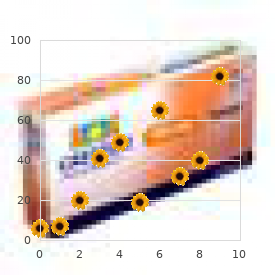
Purchase lady era 100mg with mastercard
However, sufferers with advanced-stage illness may succumb rapidly from disease progression or, in a minority, following transformation. In sufferers with complicating autoimmune hemolytic anemia, there are spherocytes and polychromasia. The neoplastic infiltrate consists predominantly of small lymphocytes with low numbers of prolymphocytes and para-immunoblasts. Prolymphocytes are slightly bigger than small lymphocytes with a dispersed chromatin pattern and a small central nucleolus. Para-immunoblasts are medium-sized cells with an open chromatin sample, prominent central nucleolus and average amounts of basophilic cytoplasm. Prolymphocytes and para-immunoblasts could also be present in greater numbers in some areas of the infiltrate. Those areas usually present greater proliferation and are referred to as proliferation facilities. Four patterns of infiltration are seen � interstitial, nodular, nodular-interstitial and diffuse. The interstitial pattern is characterized by neoplastic cells infiltrating individually between normal hemopoietic precursors and fat cells. Nodular-interstitial infiltration is a mix of the nodular and interstitial patterns. In different sufferers with more superior disease, the everyday scientific findings are lymphadenopathy, splenomegaly and, much less usually, hepatomegaly. In some sufferers, the initial presentation is with herpes zoster or with signs and signs of anemia ensuing from autoimmune hemolytic anemia with a constructive direct antiglobulin check. The lymphocytes sometimes have a high nucleocytoplasmic ratio, condensed chromatin and an inapparent or barely apparent nucleolus. There could also be as a lot as 10% prolymphocytes (atypical cells with bigger, extra prominent nucleoli). The presence of more than 10% prolymphocytes or of a spectrum of cells from small to massive, with cytoplasmic basophilia, could additionally be related to elevated proliferation and disease progression. If the number of prolymphocytes exceeds 55% a diagnosis of prolymphocytic leukemia ought to be thought-about. At low power proliferation facilities appear paler than the encompassing areas, and if numerous can provide the infiltrate an appearance of nodularity. In the spleen, infiltration leads to enlargement of the white pulp, with some instances also having involvement of the red pulp. In uncommon sufferers, a transformation towards Hodgkin lymphoma has been described and Epstein�Barr virus has been implicated in pathogenesis of this transformation. Immunogenetic research have suggested that antigen stimulation could also be concerned in illness improvement. Interestingly, it was recently indicated that stereotyped subsets might not only share organic but in addition clinical features. Several recurrent aberrations have been characterized, where the most frequent are deletion of 13q14 (50� 55%), deletion of 11q22-23 (12�18%), trisomy 12 (11�16%) and deletion of 17p13 (5�10%). Frequency of leukemic presentation and immunophenotypes of cells that may be present in blood and bone marrow are summarized in Table 29. In some sufferers, the majority of neoplastic cells are typical large prolymphocytes with massive distinguished nucleoli. Bone marrow the bone marrow is infiltrated by cells with similar cytologic features to those in the peripheral blood. The bone marrow trephine biopsy often exhibits an interstitial sample of infiltration, but nodular�interstitial and diffuse patterns are additionally seen. Clinically significant involvement of other tissues, together with lymph nodes, is uncommon. Immunophenotype the neoplastic cells in the majority of sufferers present robust expression of surface membrane immunoglobulin. These sufferers usually present complex karyotypes which may embody deletion of 6q and structural aberration of chromosome 1.
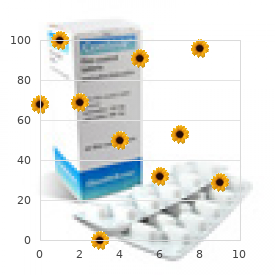
Purchase lady era on line
Eliminating delays in acceptable antibiotic administration will increase survival by ~7�10 %/h [26]. Diagnostic Approach to the Septic Patient Unfortunately, despite the big human and monetary influence of sepsis, this diagnosis stays largely a clinical one [28], because of the dearth of fast, delicate, and particular laboratory exams to detect the causative pathogens. Requirements for an Interdisciplinary Sepsis Team As with all advanced ailments, the diagnostic approach to sepsis is multifaceted. Laboratory collaboration with Emergency Medicine Departments and Critical Care Services is important. Laboratories can take part by partnering with the complete health care group, setting objectives to present fast laboratory testing to maximize effectiveness of early goal-directed therapy, improve targeted antibiotic remedy, shorten antibiotic remedy duration, avoid improvement of antibiotic resistance and side effects, lower mortality and morbidity, lower length of stay, and decrease total hospital costs. The scientific microbiology laboratory should assist drive antibiotic intervention in partnership with pharmacists and physicians. Upon presentation of a affected person with symptoms of an infection, physicians will search the first site of an infection and try and direct therapy to that main website. For instance, important factors embody the source of infection, community- or hospital-acquired; prior or current medications; current manipulations or surgical procedure; underlying or chronic diseases; and journey historical past. Combining a big selection of clinical assessments with numerous laboratory exams from scientific microbiology, hematology, chemistry, point-of-care testing, and blood gas laboratories is an important side of the optimum care and therapy of septic patients. Other Evidence-Based Sepsis Guidelines the Surviving Sepsis Campaign is a worldwide consortium of well being care providers dedicated to improving the outcomes for patients with sepsis [21, 30]. All parts of the "Surviving Sepsis Campaign Guidelines" are targeted on decreasing mortality through the use of standardized criteria for affected person assessment and remedy. Physicians should place invasive strains and monitor resuscitation of sufferers closely. Nurses should carry out frequent blood draws, handle multiple drugs (including pressors), and tailor prescribed therapy based upon numerous parameters-some of which can be measured continuously, and a few of which require periodic blood draws. Overly delicate standards may result in over-administration of antibiotics, growing bacterial resistance and placing sufferers at danger of experiencing side effects from allergic response to organ toxicity. In the occasion of hypotension and/or lactate >4 mmol/l (36 mg/dl): (a) Deliver an preliminary minimum of 20 ml/kg of crystalloid (or colloid equivalent). Inspiratory plateau pressures maintained <30 cm H2O for mechanically ventilated sufferers. Drotrecogin alfa (recombinant activated Protein C, aka Xigris) administration was previously listed right here, but it has since been withdrawn from use after a serious study confirmed no Xigris efficacy for the therapy of sepsis [31, 32]. Historic Laboratory Methods for Blood Cultures Current laboratory strategies for identification and characterization of bloodstream pathogens are gradual to produce helpful outcomes and are ineffective for detection of some pathogens [33]. Rapid detection of bloodstream infections within the critically unwell followed by appropriate antimicrobial remedy, can have a life-saving influence. Thus, the event of a speedy, sensitive, and accurate 44 Molecular Niches for the Laboratory Diagnosis of Sepsis 853 molecular diagnostic laboratory technique to determine bacterial and fungal pathogens and characterize associated antimicrobial resistance has great potential to profit prognosis and therapy for septic sufferers, and save many lives. In addition, direct susceptibility testing for micro organism [44�49] and yeast [50] have been reported. Despite makes an attempt to rapidly establish pathogens and their associated susceptibility, these techniques are nonetheless not a standard practice and patients and their physicians proceed to await confirmatory results from blood cultures, the gold commonplace for diagnosis of bacterial sepsis, which might take several days to develop out a pathogen, limiting their usefulness in the management of the acutely unwell patient. Moreover, blood cultures can incessantly remain negative even in severe instances of sepsis. For example, routine methods are relatively ineffective for detection of sure pathogens, similar to Coccidioides sp. Despite its massive societal impression, historic detection strategies for bacteremia and sepsis stay largely unchanged for the previous 20 years. Unfortunately, regardless of the enormous human and financial impact of sepsis, its diagnosis stays largely a medical one [28], because of the shortage of rapid, sensitive, and particular laboratory exams to detect the causative pathogens. Routine diagnostic methods, together with routine cultures for bacteria, fungi, and barely, viruses, virtually all require subsequent subculture for organism identification, and the complete process can take days to weeks to produce a final result. Wolk complexities of the host immune response during sepsis, which appears important to the understanding of associated multiple-organ dysfunction and dying.
References
- Marshall JC. Why have clinical trials in sepsis failed? Trends Mol Med. 2014;20:195-203.
- Lang K, Boldt J, Suttner S, et al: Colloids versus crystalloids and tissue oxygen tension in patients undergoing major abdominal surgery, Anesth Analg 93:405-409, 403rd contents page, 2001.
- Ruengsakulrach P, Sinclair R, et al. Comparative histopathology of radial artery versus internal thoracic artery and risk factors for development of intimal hyperplasia and atherosclerosis. Circulation 1999; 100 (Suppl): II139.
- Berkes MG, Little MT, Pardee NC, et al. Defining the lateral and accessory views of the patella: an anatomic and radiographic study with implications for fracture treatment. J Orthop Trauma. 2013;27(12):663-671.
- Rajagopalan N, Garcia MJ, Rodriguez L, et al. Comparison of new Doppler echocardiographic methods to differentiate constrictive pericardial heart disease and restrictive cardiomyopathy. Am J Cardiol 2001; 87:86-94.
- Birch JM, Blair V, Kelsey AM, Evans DG, Harris M, Tricker KJ, Varley JM (1998). Cancer phenotype correlates with constitutional TP53 genotype in families with the Li-Fraumeni syndrome. Oncogene 17: 1061-1068.
- Akikusa B, Kondo Y, Irabu N, Yamamoto S, Saiki S. Six cases of microscopic polyarteritis exhibiting acute interstitial pneumonia. Pathol Int 1995;45(8):580-8.
- Beale RJ, Gough MJ: Treatment options for primary varicose veins - a review, Eur J Vasc Endovasc Surg 30(1):83-95, 2005.



